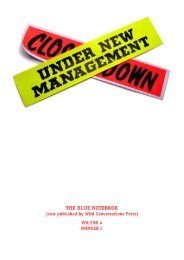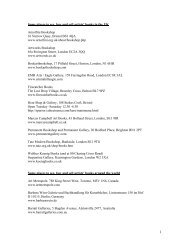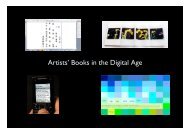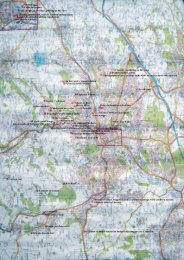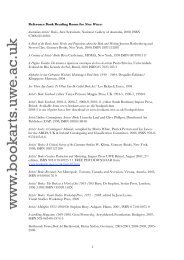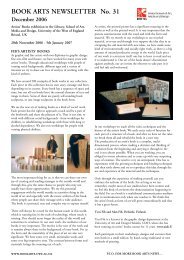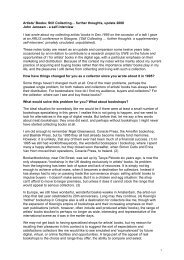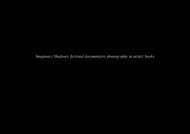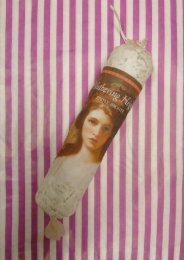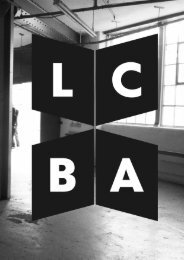Artist's Book Yearbook 2003-2005 - Book Arts - University of the ...
Artist's Book Yearbook 2003-2005 - Book Arts - University of the ...
Artist's Book Yearbook 2003-2005 - Book Arts - University of the ...
You also want an ePaper? Increase the reach of your titles
YUMPU automatically turns print PDFs into web optimized ePapers that Google loves.
Gli Italiani - The Italians<br />
Carrie Galbraith<br />
“The book is a place where you can wait for<br />
somebody, a place in which to search for<br />
something that is lost, or perceived lost, and to<br />
find it again, in your hands, through <strong>the</strong><br />
pages.” - Roberta Bridda<br />
Class in Libro d’Artista Scuola Internazionale di Grafica,<br />
Venice, 2002<br />
Italy has a long tradition <strong>of</strong> artists making<br />
books, from illuminated manuscripts to<br />
innovative early printers, from <strong>the</strong> Futurists to<br />
artists and designers such as Bruno Munari in<br />
<strong>the</strong> 60s and 70s. Today <strong>the</strong>re are a number <strong>of</strong><br />
small independent presses and artists working<br />
in <strong>the</strong> book form in Italy such as Corraini in<br />
Mantua and Alberto Casiraghy and his Edizioni<br />
Pulcino Elefante. In this article, I have chosen to<br />
focus on six artists who, unlike <strong>the</strong> monk<br />
labouring a lifetime in <strong>the</strong> scriptorium, vary<br />
greatly in <strong>the</strong>ir disciplines and age. They are<br />
architects, designers, anthropologists, social<br />
workers and teachers yet <strong>the</strong>y share <strong>the</strong><br />
common bond <strong>of</strong> <strong>the</strong> love <strong>of</strong> <strong>the</strong> book. They<br />
have all studied at <strong>the</strong> Scuola Internazionale<br />
di Grafica in Venice, whose artistic director,<br />
Matilde Dolcetti, has been a great influence<br />
and supporter <strong>of</strong> <strong>the</strong>ir explorations.<br />
83<br />
In interviewing <strong>the</strong> artists, I focused on <strong>the</strong><br />
individuals approach to <strong>the</strong> process, specifically<br />
asking <strong>the</strong>m <strong>the</strong>ir interpretation <strong>of</strong> <strong>the</strong> artist’s<br />
book. The artists have responded candidly to<br />
my questions, touching on <strong>the</strong> essence <strong>of</strong> <strong>the</strong>ir<br />
ideas and aes<strong>the</strong>tic sensitivities as well as <strong>the</strong>ir<br />
processes.<br />
All <strong>of</strong> <strong>the</strong> artists have seen many international<br />
exhibitions <strong>of</strong> artists’ books. They have found a<br />
“spirit <strong>of</strong> common intentions” in <strong>the</strong> books,<br />
even if <strong>the</strong> language and techniques have been<br />
different. To quote Lia Malfermoni, “each book<br />
is original, different and unique. The country<br />
<strong>of</strong> creation is <strong>the</strong> inner homeland, inside <strong>the</strong><br />
artist.”<br />
Roberta Bridda (see opposite) studied at <strong>the</strong><br />
<strong>University</strong> <strong>of</strong> Architecture in Venice and wrote<br />
her dissertation on artists’ books, placing <strong>the</strong>m<br />
in <strong>the</strong> same structural territory as buildings. In<br />
1997 she saw an exhibition <strong>of</strong> books and began<br />
considering <strong>the</strong> possibilities <strong>of</strong> <strong>the</strong> medium,<br />
describing <strong>the</strong> artists’ book as “an open shape,<br />
a home, a body and a journey.” Roberta has<br />
said that <strong>the</strong> book “creates a need to think<br />
about language, a place where codes mix<br />
toge<strong>the</strong>r, where <strong>the</strong> text can be an image and<br />
<strong>the</strong> image can also be text. With books, <strong>the</strong><br />
idea is to stay awake in front <strong>of</strong> reality and<br />
dreams, living one’s multiple lives.”<br />
Loretta Cappanera<br />
Ali di Carta (1)<br />
23 x 18cms,<br />
cut paper and<br />
collage,<br />
one-<strong>of</strong>-a-kind, 1994<br />
In 1993, while searching for a way to express<br />
her desire to communicate and give testimony<br />
to <strong>the</strong> inner journey, Loretta Cappanera began<br />
working with artists’ books. She does not<br />
distinguish between “art” and “book,” finding<br />
<strong>the</strong> book a valid vehicle by itself. For Loretta,<br />
<strong>the</strong> book is a witness to <strong>the</strong> personal vision<br />
quest and is full <strong>of</strong> movement. She perceives<br />
<strong>the</strong> materials used in <strong>the</strong> creation <strong>of</strong> <strong>the</strong> book<br />
as leading to a continuous exploration <strong>of</strong> <strong>the</strong><br />
form.




